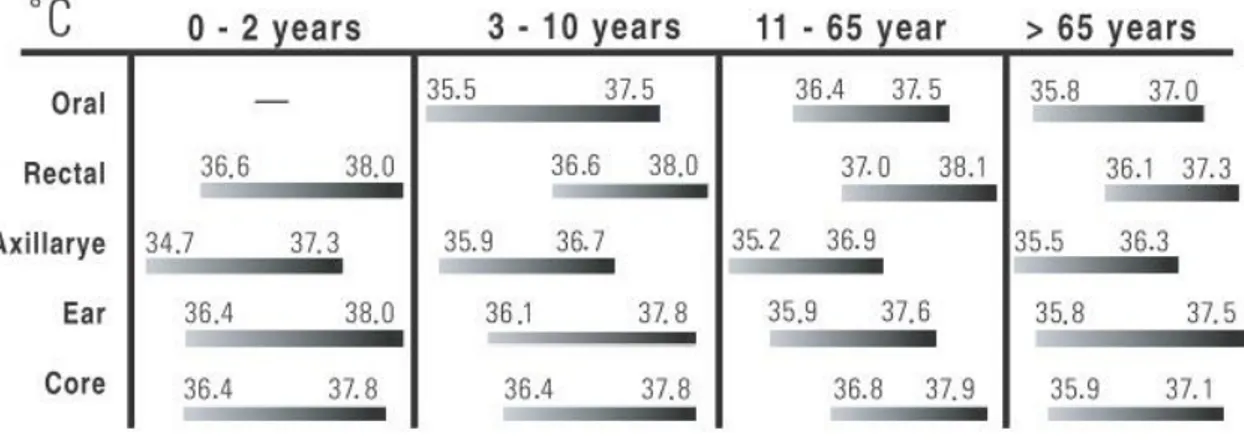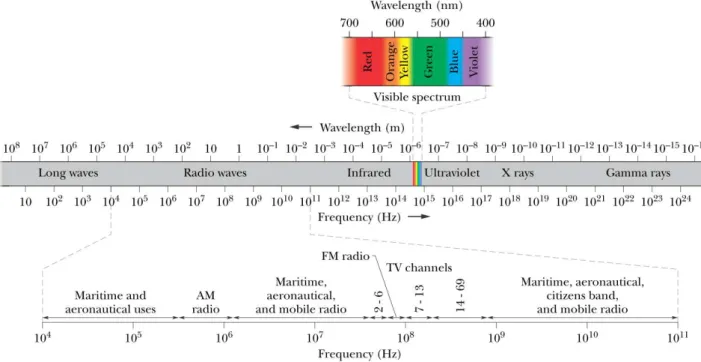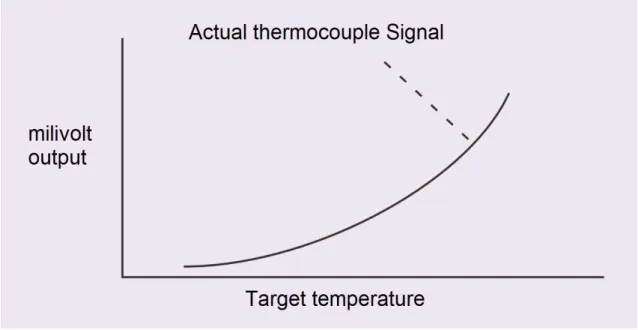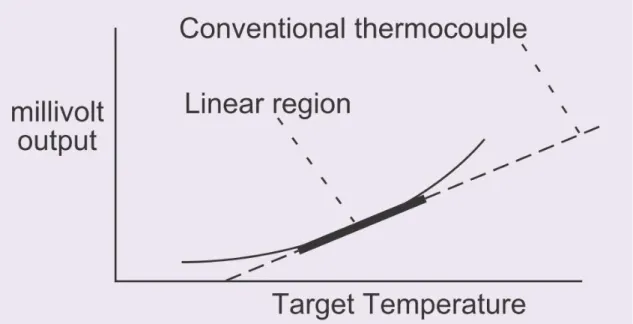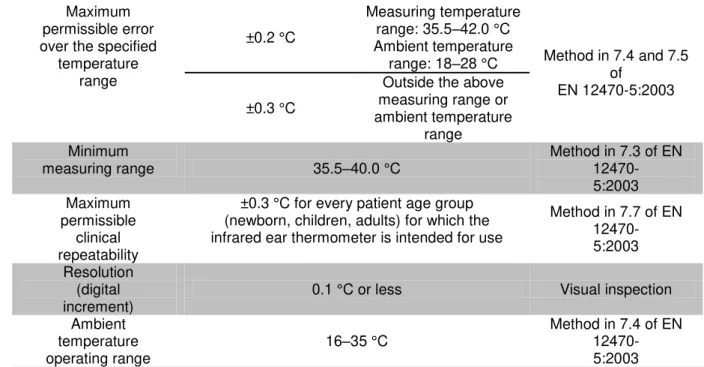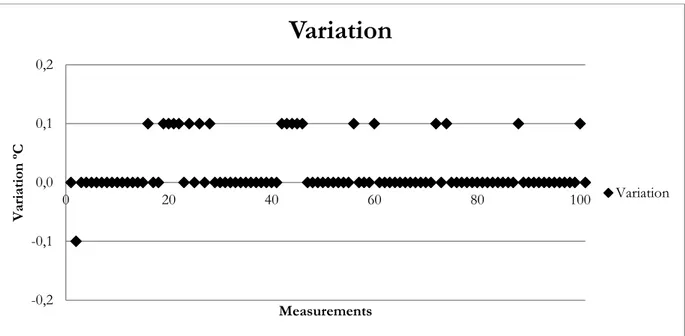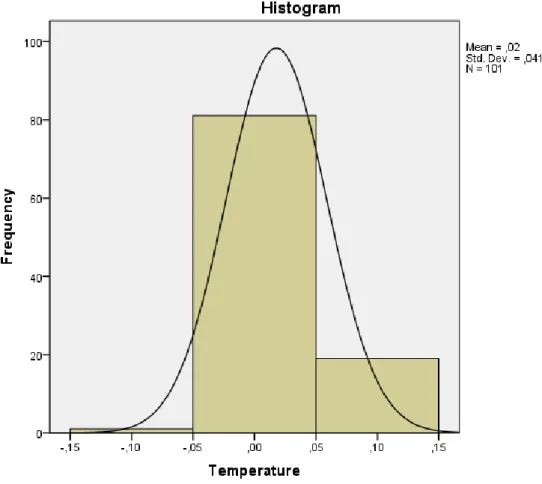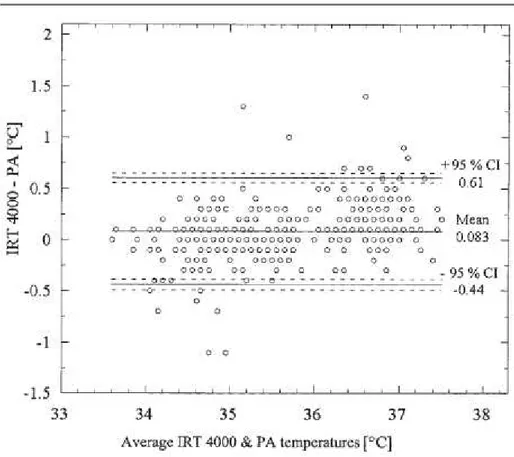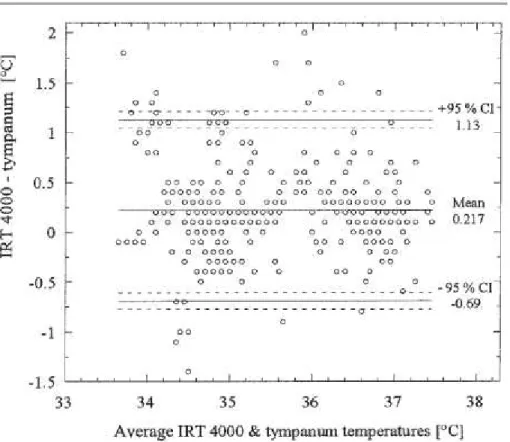Vítor Rodrigues do Nascimento
Licenciatura em Ciências da Engenharia Biomédica
Evaluation of thermometers for ear
temperature measurement at the wards
in a university hospital.
Dissertação para obtenção do Grau de Mestre em Engenharia Biomédica
Orientador: Heikki Teriö, Ph.D. R&D Manager, Karolinska
Institutet
Co-orientador: Mário Secca, Ph.D, FCT-UNL
Júri:
Presidente: Prof. Doutora Maria Adelaide de Almeida Pedro de Jesus Arguente(s): Prof. Doutor Hugo Gamboa
Vogal(ais): Prof. Doutor Mário Forjaz Secca
I
Vítor Rodrigues do Nascimento
Licenciatura em Ciências da Engenharia Biomédica
Evaluation of thermometers for ear
temperature measurement at the wards
in a university hospital.
Dissertação para obtenção do Grau de Mestre em Engenharia Biomédica
Orientador: Heikki Teriö, Ph.D. R&D Manager, Karolinska
Institutet
Co-orientador: Mário Secca, Ph.D, FCT-UNL
II
Evaluation of thermometers for ear temperature
measurement at the wards in a university hospital.
Copyright © 2012
Vítor Rodrigues do Nascimento, FCT/UNL, UNL.
A Faculdade de Ciências e Tecnologia e a Universidade Nova de Lisboa têm o direito, perpétuo
e sem limites geográficos, de arquivar e publicar esta dissertação através de exemplares impressos
reproduzidos em papel ou de forma digital, ou por qualquer outro meio conhecido ou que venha
a ser inventado, e de a divulgar através de repositórios científicos e de admitir a sua cópia e
distribuição com objectivos educacionais ou de investigação, não comerciais, desde que seja dado
crédito ao autor e editor.
Faculdade de Ciências e Tecnologia and Universidade Nova de Lisboa have the perpetual and
unlimited geographic right to archive and publish this dissertation through printed or digital
versions or any other known or still to be invented way, and to disclose it through scientific
repositories and to admit its copy and distribution for educational or research purposes,
III
Abstract
Since mercury thermometers were banned due to environmental concerns, hospitals started to use
electronic thermometers for measuring body temperature. Body temperature can be measured
from different body parts, although the least invasive and quickest is preferred and therefore
eardrum measurements are frequently taken. However, lately the staff feels that the taken
measurements are not accurate. A new purchasing agreement for the purchase of these devices
renders a good opportunity to study further the use of these devices at the wards of the university
hospital, study their maintenance process, identify what performance is essential for the clinical
usage, the parameters that are essential to measure and also identify ear thermometers in the
market that can be used for comparative study.
Temperature measurements were taken with the help of an infrared ear thermometer, Covidien
Genius2, in its calibration blackbody device at the R&D department of the Huddinge Hospital in
order to verify accuracy claims. This data were compared against other studies and measurements
of other infrared ear thermometers devices, the Braun ThermoScan Pro 4000 and also a digital
contact thermometer, Welch Allyn Suretemp Plus, applied to different body sites. Informal
meetings also took place in order to get more information about the devices and to know where
they were used and repaired.
It was found that Genius2 measured temperature accurately when compared with a blackbody
radiator. Regarding the Braun, it showed an accurate estimate of core temperature in comparison
to invasive pulmonary artery catheter thermometry.
Electronic tympanic thermometers proved to be a good replacement for conventional methods of
thermometry. However, preventive maintenance should occur more often, since the devices are
very fragile. Tympanic thermometers are generally very accurate instruments. Most likely,
problems are not related to the thermometers themselves, they are possibly the result of an
IV
Resumo
Desde que o uso de termómetros de mercúrio foi proibido, começaram a ser utilizados nos
hospitais termómetros electrónicos para medição da temperatura corporal. A temperatura corporal
pode ser medida em diversos locais no corpo, mas tendo em conta que é preferível uma medição
mais rápida e menos invasiva, é costume que as medições sejam feitas no tímpano. Contudo,
ultimamente o staff do hospital sente que as medições não são precisas. O novo acordo de compra
para este tipo de aparelhos é uma boa oportunidade para estudar melhor o seu uso no hospital, o
seu processo de manutenção, identificar a performance essencial para uso clinico, parâmetros
essenciais para a medição e identificar que tipo de termómetros timpânicos no mercado podem
ser usados para um estudo comparativo.
Usando um termómetro timpânico, Covidien Genius2, mediu-se, no Hospital de Huddinge, a
temperatura no aparelho de calibração (corpo negro) para verificar a sua precisão e exactidão.
Comparou-se com estudos e medições de outros termómetros, Braun ThermoScan Pro 4000 e
Welch Allyn SureTemp Plus (termómetro contacto) aplicados e comparados com diferentes
partes do corpo. Houve várias reuniões com o staff de forma a ter mais informação sobre os
aparelhos, saber onde se encontram e como são reparados.
Verificou-se que o Genius2 mediu correctamente a temperatura, quando comparado com o corpo
negro. O Braun tem uma estimativa precisa da temperatura corporal quando comparado com um
cateter arterial pulmonar.
Os termómetros timpânicos provam ser uma boa alternativa aos métodos convencionais de
termometria, contudo a manutenção preventiva deve ocorrer mais frequentemente. Muito
provavelmente os problemas não estão relacionados com os aparelhos em sim, mas devido à falta
de compreensão das limitações da termometria timpânica.
Key Words
Electronic ear thermometer, tympanic thermometer, thermometry, infrared, total cost of
ownership, temperature.
Palavras-chave
Termómetro auricular digital, termómetro timpânico, infra vermelho, custo total de posse,
V
Index
Abstract ... III
Resumo ... IV
Key Words ... IV
Index ...V
Figure index ... IX
Table index ... XI
1. Introduction - Analysis of the situation ... 1
2. State of the art ... 5
3. Methods used ... 11
3.1 Overview ... 11
3.2 Meetings ... 11
3.3 Experiments and data gathering ... 11
3.4 Market Analysis ... 12
4. Temperature ... 13
4.1 Normal Temperature ... 14
4.2 Fever ... 15
4.3 Hypothermia ... 15
5. Thermometry ... 17
5.1 Oral ... 17
5.2 Ear / Tympanic ... 18
5.3 Axillary ... 18
5.4 Rectal ... 18
5.5 Temporal ... 19
5.6 Core ... 19
5.7 Infrared sensing thermometers ... 19
VI
5.7.2 How they measure temperature ... 20
5.7.3 Thermopile ... 21
5.8 Hospital equipment ... 24
6. Essential parameters ... 25
6.1 Essential Principles of Safety and performance of Medical devices ... 25
6.2 Accuracy and Clinical repeatability ... 26
6.3 Total cost of ownership, product life and maintenance ... 26
6.4 Breakdowns and down time ... 27
6.5 Performance according to specification ... 27
6.6 Cleaning and infection control issues ... 27
6.7 Storage and ambient operating environment ... 27
6.7.1 Effect of (ambient) conditions ... 28
6.7.2 Electromagnetic Interference ... 28
6.8 Lifetime costs ... 28
6.8.1 Disposable/sterile covers ... 28
6.8.2 Batteries ... 29
6.8.3 Re-Calibration ... 29
6.8.4 Maintenance costs ... 29
7 Clinical use ... 31
8 Manufacturing Standards ... 33
8.1 CE Marking ... 33
8.2 International safety and performance standards ... 34
9 Result of comparison ... 37
9.1 Calibration and Maintenance Process ... 37
9.1.1 Covidien Genius 2 ... 37
9.1.2 Braun ThermoScan Pro 4000 ... 38
9.1.3 Welch Allyn SureTemp ... 38
10 Data and Results ... 41
VII
10.2 Accuracy claims ... 43
10.2.1 Covidien Genius2 ... 43
10.2.2 Braun ThermoScan Pro 4000 ... 45
10.2.3 Welch Allyn Suretemp ... 48
10.2.4 Braun ThermoScan Pro4000 and Covidien Genius2... 53
11 Discussion of results... 61
11.1 Market Analysis ... 36
12 Conclusions ... 63
Bibliography ... 65
A. Printed Sources ... 65
B. Manuals ... 67
C. Electronic Sources ... 68
Annex I – Market Research ... 69
A Cute Baby MT510 Infrared Ear Thermometer ... 70
A Cute Baby MT511 Infrared Ear Thermometer ... 71
Actherm 8000R ... 72
Alaris Med IVAC Core-Check ... 73
Beurer FT-55 ... 74
Bosotherm Medical ... 75
Braun IRT 3020 ... 75
Braun ThermoScan 4000 ... 76
Comdek Industrial HD-7 ... 78
Comdek Industrial HD-11 ... 79
Comdek Industrial HD-21 ... 80
Covidien Genius2 ... 81
DigiO2 ETH-101 ... 82
Easytem BT-020 ... 83
Easytem BT-021 ... 84
VIII
Exergen Ototemp Light touch ... 86
GF Health Products Deluxe Instant-Read Ear Thermometer Model 2215 ... 87
HuBDIC NET100 ... 88
HuBDIC NET100 ... 89
Microlife IR 100 ... 90
Microlife IR 120 ... 91
Microlife IR 1DA1 ... 92
Omron Gentle Temp MC-510-E ... 93
Predictor Ear Thermometer ... 94
Riester ri-Thermo N Professional ... 95
Rossmax TD100 ... 96
Rossmax TE100 ... 97
Spengler Temp'O ... 98
Topcom Ear&Forehead 301 ... 99
Veridian VTemp Pro ... 100
Devices Specifications ... 101
IX
Figure index
Figure 2.1 Galileo’s first thermometer ... 5
Figure 5.1 The electromagnetic Spectrum ... 20
Figure 5.2 General scheme of the evolution of the output and the target temperature ... 22
Figure 5.3 The linear region matches the conventional thermocouple to a specified tolerance .. 23
Figure 5.4 General scheme of a thermopile ... 23
Figure 5.5 Distribution of the devices according to their type ... 25
Figure 8.1 Flowchart depicting the process of CE Marking ... 33
Figure 10.1 Scatter Plot for Covidien Genius2 measurement ... 43
Figure 10.2 Histogram for Covidien Genius2 measurement ... 44
Figure 10.3 Bland Altman plot: ThermoScan Pro 4000 vs. pulmonary artery catheter. ... 46
Figure 10.4 Bland Altman plot: ThermoScan Pro 4000 vs. tympanic membrane probe. ... 47
Figure 10.5 Welch Allyn Monitor mode Vs Paediatric axillary mode ... 49
Figure 10.6 Welch Allyn Difference between pulmonary artery and axillary temperature. ... 51
Figure 10.7 Welch Allyn Difference between pulmonary artery and oral temperature. ... 51
Figure 10.8 Covidien Genius2 difference between right ear and left ear and, right ear and rectal measurements ... 55
Figure 10.9 Braun ThermoScan difference between right ear and left ear and, right ear and rectal measurements ... 55
Figure 10.10 Covidien Genius2 difference between right ear and rectal and, right ear and core measurements ... 57
Figure 10.11 Braun ThermoScan difference between right ear and rectal and, right ear and core measurements ... 57
XI
Table index
Table 5.1 Normal body temperature ranges depending on site and age ... 17
Table 8.1 Key Parameters in European Standard EN 12470-5:2003 ... 34
Table 8.2 Key requirements in ASTM E1865-98 ... 35
Table 10.1 Cost estimatesof the devices used in Karolinska... 42
Table 10.2 Genius2 Frequency and percentage of the acquired measurements ... 43
Table 10.3 Statistical data ... 44
1
1.
Introduction - Analysis of the situation
Measuring body temperature is one of the most common clinical procedures in hospitals.
Temperature has been recognized as an aid in diagnosing and treating diseases (Konopad et al.
1994, Purssell et al. 2009) and core temperature, in particular provides essential information about
health and illness (Smith 1998). Temperature is an SI base quantity related to our sense of hot and
cold. It is measured with a thermometer, which contains a working substance with a measurable
property, such as length or pressure, that changes in a regular way as the substance becomes hotter
or colder (Halliday et al. 2010).
Due to Swedish regulations, the manufacture and sale of products containing mercury, such as
thermometers has been prohibited since the early 1990s. Nowadays, digital thermometers are
widely used in hospital wards or at home in order to measure body temperature. These
thermometers are, generally, either contact thermometers, which have a sensor on the tip (with
different types of sensor for each specific use), or infrared thermometers, which are almost contact
free. The most common digital thermometers are ear/tympanic, oral, axillar, rectal and pulmonary
artery catheter thermometers. Measuring the core temperature using an invasive method, like the
pulmonary artery catheter, is referred to as the gold standard for measuring body temperature
(Smith 1998, Giuliano et al. 1999, Bock & Hohfeld, 2005, Nimah et al. 2006, Edelu et al. 2011).
As this seldom is applicable outside the intensive care unit and operation room, rectal
measurement has been the standard method for centuries in clinical practice, however,
temperature changes in the rectum are relatively slow and do not always reflect the core
temperature. This is especially true for patients under general or regional anesthesia who may
develop rapid changes in core temperature (Bock & Hohfeld, 2005). Still, another common
method to determine body temperature, during daily clinical practice, is the evaluation of axillar
temperature. During the measurement, the thermometer is positioned in the axilla and the arm
should be held tight against the thorax for about four minutes or until the sound alarm is set off.
Infrared ear thermometers allow users to measure body temperature quickly and noninvasively
by inserting a probe into the patient’s ear canal. These thermometers do not contact any mucous
membranes, reducing the incidence of cross-contamination, and can be used on unconscious and
uncooperative patients. With the growing need of quick and less invasive measurement devices,
hospitals and other healthcare facilities have a strong need to introduce this kind of devices in
their wards, not only because of the patients, but also for the personnel in charge of their use. But
what is an Infrared Thermometer? According to Omega Engineering, an Infrared Thermometer is
2 materials, at temperatures above absolute zero, (0°Kelvin), converting the energy factor into a
temperature reading.
On the technical side, there are many pitfalls in the everyday usage of the ear thermometers at the
wards in a hospital, per example the devices fall on the floor, they become dirty, the batteries are
not charged properly, there is no disposable protection caps when the thermometer is needed,
calibration is not done, the staff feels that the device is difficult to use. Also, some of the technical
staff feels that some of the devices are not working properly, and asked for a revision of the
aforementioned devices. On the other hand, body temperature is one of the five vital signs
measured by health professionals. It’s predicted that 3–4 out of 10 febrile cases can be missed by
using infrared tympanic thermometers instead of rectal thermometry. The reasons are the
variability of the auditory canal, unwanted hair in the ear, the lack of reproducibility and the fact
that ear temperature can be lower than rectal temperature (Smith R et al. 2008).
A slight elevation in body temperature might lead to the prescription of medicine, prolonged stay
in a healthcare facility or other medical procedures, leading to rising costs. At home it might lead
to incorrect auto-medication, also leading to increased costs and patient safety issues.
After a literature revision it is possible to note that up until now, there have been several studies
regarding the accuracy, in a clinical setting, of previous generations of Infrared tympanic
thermometers, some revealing misdiagnosis and questioning those early models (Banitalebi et al.
2002, Nordås et al. 2005, Dodd et al. 2006, Duberg et al. 2007, Lawson et al. 2007), while others
say the devices proved to be accurate (Kocoglu & Goksu, 2002, Nimah et al. 2006, Villaescusa
et al. 2008, Jefferies et al. 2011). However there are not many studies for the new generation,
especially in a clinical practice environment. Some of the existing studies on these devices
demonstrate that the accuracy of Infrared ear thermometers is not the same as the one stated by
the manufacturers, being complicated to reach a consensus (Haugan et al. 2012).
So, since infrared tympanic thermometers are, along with digital contact thermometers for rectal
and axillary temperature measurements, the most common way to measure patient’s temperature,
it is necessary to measure their reliability, ownership costs and accuracy with other known and
reliable body temperature monitoring sites.
The hospitals in the region of Stockholm (Stockholm County Council) are reduced to buy new
infrared ear thermometers according to the agreement from the purchasing process in late 2011.
This proved to be a good opportunity to start a new study on these devices. This agreement is for
three years with the possible extension of one year. The supplied equipment is calculated
according to hospital needs in a 3 year interval, but also based on historical data from purchasing
3 The equipment that is to be compared is electronic tympanic thermometers that are currently in
the market, which have replaced conventional mercury thermometers and rectal or axillary
thermometers in the hospital wards. This comparison covers infrared thermometers that measure
patient temperature by collecting emitted thermal radiation from the ear canal and/or tympanic
membrane and displaying the temperature in Celsius or Fahrenheit degrees on a liquid crystal
display (LCD) or light-emitting diode (LED) display.
The purpose of this report is to identify the essential performance parameters for the clinical usage
5
2.
State of the art
Nowadays temperature control and measurement are of the utmost importance, whether it is in
industries (chemical, plastic, paper, automobile, pharmaceutical, and aviation), laboratories, home
or the human body (TME Electronics). In the past such measurements where not accurate and
they were difficult to make, and most of the times they were based on sensorial experiences, rather
than on physical or chemical processes. Due to these reasons, there was a great need to create
some kind of instrument that could consistently measure a correct temperature, no matter the user – the thermometer, which is the standard device to measure body temperature.
Regarding the human condition, body temperature, pulse, respiratory rate, blood pressure and
pain are the five vital signs that show the organism’s capability to control body temperature, blood
flow and oxygenation of body tissues in the presence of environmental change, physical and
psychological stress (Oliveira D. 2010).
The following section encompasses the evolution of the thermometer and thermometry and is based on some sources, but mostly Cabral, P. essay “Breve História da Medição de
Temperaturas”, Ostman H. “The evolution of the thermometer” and TME Electronics “The history
of thermometers”.
Historical records date the first attempt to establish a temperature scale around 170AD, by the
hand of Greek doctor Claudius Galenus of Pergamum (129 – 201AD). He suggested that the hot
and cold feelings should be measured on a scale with four divisions,
above and under a neutral point. In that scale he assigned, to boiling
water, the designation of “4 degrees of heat” and, to ice, was
assigned the designation of “4 degrees of cold”. The neutral scale
was a mix of equal quantities of both substances, boiling and ice
water.
In spite of thermometry dating to remote times, the invention of the
first “thermometer” is credited to Galileo Galilei (1564 – 1642AD).
The device consisted on a small glass vessel with colored water,
where the tip of a thin glass tube was inserted, suspended, and with
a hollow sphere on the opposite extremity. An increase of the air in
the hollow sphere’s temperature expands the air, making the liquid
go down, and a decrease of the temperature would make the liquid
rise. Even though this device is able to register a temperature change, the absence of a scale means
6 that the device is, in fact, a thermoscope. A “true thermometer” must include a temperature sensor
where physical change occurs with changes in temperature - and a means of converting that
physical change into a readable value. For a long time, this meant a bulb (containing some form
of liquid) and a scale, generally displayed on the tube through which the liquid expanded or
contracted with changes in temperature.
The first “truethermometer” is credited to Robert Fudd (1574 – 1637AD), since it was the first
diagram with both temperature sensor and scale, but the first person that developed the idea of
the thermometer and actively used it was Santorio Santorio (1561 – 1636AD). He developed a
clinical thermometer, using it to produce an estimated heat of a patient’s heart by measuring the
heat of his expired air.
In 1644, Evangelista Torricelli (1608 – 1647AD) discovered the variability of air pressure so,
unfortunately, all the early thermometers and thermoscopes suffered of the same design flaw.
They were sensitive to air pressure as well as temperature, functioning, therefore also as a
barometer, rather than a pure thermometer.
In 1654, Ferndinando II de’Medici (1610 – 1670AD) created the first thermometer, which gave a
clear reading of temperature, unaffected by any other factor. He used a liquid instead of air as a
thermometric mean, sealing a tube with alcohol, with an engraved arbitrary scale of 50 degrees,
although there was no point marked as a zero. He also created the first blueprints for many
thermometer manufacturers, but there was one big problem. Each manufacturer had its own scale
and own system for temperature measurement. The scales were not standardized or calibrated to
one another.
In 1664, the London Royal Society proposed the use of Robert Hook’s (1635 – 1703AD)
thermometer scales as a standard. He used red dye on alcohol and although his scale was volume
dependent (each degree was 1/500 of the total volume of the liquid in the thermometer), it had a
fixed point. Water’s freezing point. Still, the London Royal Society had no real power to
implement Hook’s scale, but slowly a scale evolved Christian Huygens in 1665 suggested the
melting and boiling points of water as standard lower and upper limits, and in 1701 Isaac Newton
(1643 – 1727AD) proposed a scale of twelve degrees, with the extremes being melting ice and
body temperature.
In 1702, Danish astronomer Ole Rømer (1644 – 1710AD) also used two fixed points in his scale,
the upper value was the armpit temperature of a healthy adult and the lower limit was a mixture
of salt and ice. It was after Daniel Gabriel Fahrenheit (1686 – 1738AD), German physicist and
engineer, visited Rømer in 1708, and started to use his scale in 1724, that it really caught on.
Fahrenheit was also the first manufacturer to use mercury in thermometers instead of alcohol.
7 temperature change, and so a thermometer containing it can produce a more accurate reading than
a thermometer using alcohol. So Fahrenheit’s thermometers became the most popular designs,
and eventually the standard ones. Fahrenheit’s scale is still used nowadays in the U.S.A.
Still, the scale most widely used in thermometers of all kind is the Celsius scale. The Celsius scale
was developed in 1742 by Anders Celsius (1701 – 1744 A.D.), a Swedish astronomer who devised
a scale of 100 degrees, with zero as the boiling point of water and 100 as its freezing point. As he
died just two years later, his assistant Carolus Linnaeus was instrumental in developing and
publicizing the scale, and in encouraging its use among thermometer manufacturers. Linnaeus
reversed the scale, making zero the freezing point of water and 100 its boiling point, and used it
in his patented Linnaeus-thermometers, which were thermometers for use in greenhouses. In 1794
it was defined that a thermometric degree should be the hundredth part of the distance between
the freezing and boiling temperature of water, giving birth to the centigrade scale, other
denomination for the Celsius scale. The scale caught on and, since about 1950 has been the most
widely used on all almost all kinds of industries and thermometers, with the exception of some
scientific fields such as astrophysics, where the Kelvin scale is used.
The development of thermometers has moved quickly since the eighteenth century. In 1866, Sir
Thomas Clifford Allbutt (1836 – 1925AD) devised a clinical thermometer which produced a body
temperature reading in five minutes rather than twenty. Since then, thermometers have become
essential and highly accurate devices used to analyze and control chemical reactions in fields as
diverse as astrophysics, restaurant catering, and electronical manufacture.
Since the introduction of the International Temperature Scale in 1990 many different thermometer
designs have been required to cover the whole range of temperatures. These range from ‘absolute zero’, where all energy (expressed as heat) has been removed from a substance or atmosphere, to very hot temperatures – thermometers have been developed that can even measure the temperature
of the surface of the sun (5526 degrees Celsius).
Nowadays, many different types of thermometer exist, including the alcohol thermometer, the
mercury thermometer, the medical thermometer, the reversing thermometer, the maximum
minimum thermometer, the thermistor, the thermocouple, the coulomb blockade thermometer,
the Beckmann differential thermometer, the bi-metal mechanical thermometer, the silicon band
gap temperature sensor, and the liquid crystal thermometer. However, the most common in
general manufacturing purposes is still the electronic thermometer, which uses tiny microchips to
pick up and to measure information on temperature.
The thermocouple is now the most widely used thermometer, or 'temperature sensor.' It uses
electrical technology to show temperature. Two metals are used, one contained within the
8 substance or atmosphere. The word 'thermocouple' comes from the idea of the 'coupling' of two
different metals.
The difference between their temperatures is expressed electrically through their difference in
voltage. As the temperature of the metal inside the thermocouple is already known, the difference
between the two temperatures can let us easily deduce the temperature of the metal attached to
the probe. This deduction is usually carried out electronically by a tiny microchip inside the
instrument, so that the scale or display on a thermocouple thermometer simply shows the
temperature which the probe has sensed.
Thermocouples are used extensively in electrical engineering and industry. For instance, they are
essential in fields such as heating appliance safety, radiation testing and in many areas of
manufacture. The principle behind thermocouples was discovered by the German-Estonian
physicist Thomas Johann Seebeck (1770 – 1831AD) in 1821, and is known as the thermoelectric
effect or Seebeck effect.
In 1867, English physician, Sir Thomas Allbutt (1836 – 1925AD) invented the first practical
medical thermometer used for taking the temperature of a person.
In 1884, Ludwig Boltzmann (1844 – 1906AD) derives Josef Stefan's (1835 – 1893AD) black
body radiation law, being named father of infrared thermometry. In 1899, the first patent for a
disappearing-filament optical pyrometer is granted to Everett F. Morse. In 1931 the first total
radiation thermometer is made available. In 1977, the first miniature thermopile appears,
decreasing its size to 4 mm2. In 1984, Theodore Hannes Benzinger (1905 – 1999AD), a German
surgeon invented the first ear thermometer, with Englishman David Phillips inventing the first
infrared ear thermometer, receiving the Inventor of the Year Award in 1986.
Regarding clinical thermometers, the development of infrared thermometers, brought us temporal
artery scanners, and some devices are now ear, forehead and ambient thermometers. Nowadays,
infrared ear thermometers are getting smaller, more accurate, they require less radiation to achieve
a usable signal, have a faster response time between carrying the measurement and displaying the
result and, of course, are now cheaper due to the mass production. There are several companies
worldwide, such as Braun, Covidien, Omron, Exergen, Microlife, Comdek, among several others,
investing in research and development of safe, accurate and reliable thermometers. In the future
it might be possible to constantly monitor patient’s temperature, with such a device. Infrared
tympanic thermometers were of great importance during the SARS epidemic outbreak between
November 2002 and July 2003, enabling rapid and accurate checking of body temperature at the
Lo Wu Border between Hong Kong and continental China. The use of these devices was pivotal
9 New clinical thermometers may be in the form of pills, like the CorTemp, with the temperature
display in a near monitor and the receiver is a small and thin coil placed under the sheet or
mattress, lasting up to eight days or more. It is possible to record a temperature measurement
every 30 seconds with memory up to 4500 measurements. It is also possible to turn it off remotely.
They are more practical, cheaper and safer than catheters and require no surgery.
Much has changed since 170AD, however, the basic principles for measuring temperature still
remain the same. All thermometers require a temperature sensor and a means of translating a
change in temperature into a numerical value. For example, in a mercury thermometer the
temperature sensor is the mercury. The change in numerical value is registered on the scale on
11
3.
Methods used
3.1
Overview
During the working period a study plan was developed, several meetings were held with
technicians and nursing staff to discuss general characteristics, learn about the maintenance
procedures and problems associated with the devices. Experiments and data collection from the
inventory systems were carried out in the Biomedical/R&D department and a market analysis was
also conducted.
3.2
Meetings
The meetings were held with several technicians (Laszlo Fabian, Pernilla Holm, Pierre Foglöv,
and some of the nursing staff). On one of the meetings there was a visit to the neonatal ward of
the hospital. The meetings were informal, and consisted on information and advice exchange.
Laszlo provided some of the device manuals and his expertise on how to do the calibration and
maintenance of the devices.
Pernilla talked about previous experience, the motive behind the previous research and the
problems encountered when making the device measurements. She found that the devices had a
temperature variation of 0.8ºC, with standard deviation of 0.4ºC. She also proposed some
alternatives to the devices.
Pierre gave his input regarding Infrared thermometry and the standards used in Karolinska,
Huddinge, also referring to some previous research on infrared thermometry (Falk et al. 2003).
The nursing staff gave their opinions on the devices, their most common problems and difficulties.
Everybody gave their input regarding the devices being used in the hospital, their pros and cons,
and also a better perspective on how to attack the problem.
3.3
Experiments and data gathering
Experiments were done at the Biomedical/R&D department of the Huddinge Hospital. They
consisted on temperature acquisition with the Genius2 thermometer with the aid of its calibration
device.
The device was connected, and the instructions in the monitor were followed. For one
measurement, a new probe cover was installed and a measurement was taken in the low
temperature blackbody. The cover was then ejected and replaced by a new one and a new
measurement was taken in the high temperature blackbody. The temperature difference was then
12 The calibration device also gave a log with the ambient temperature at the time of the calibration.
For the other devices, the data was gathered on scientific papers, independent research, through
Welch Allyn and the medical device inventory system (both the old and the new, which has
replaced the system that had been developed in Karolinska for over 20 years). This data was later
processed either with MS Excel or SPSS.
3.4
Market Analysis
The market analysis was conducted by an on-line search, exchanging e-mails with the
manufacturers, suppliers and reading the adequate literature (References B and C). A total of
thirty one thermometers were analyzed. 4 thermometers provide an oral equivalent temperature
while the other twenty seven provide the ear temperature. 12 provide either a “3-in-1” (ear,
ambient and surface temperature) or a “2-in-1” (ear and forehead temperature) system, 10 are
thermometers that provide ear temperature, the other 2 oral. There is also one thermometer that
can display several offsets (oral, rectal, ear and core). The specifications of these devices can be
13
4.
Temperature
It is of the utmost importance to accurately measure body temperature at the wards of a hospital.
A slight temperature elevation may lead to drug prescriptions, longer time in the hospital or
surgical procedures, leading to rising costs and risking patient safety. For these reasons it is
important to safely and accurately monitor body temperature.
Body temperature can be comprised by the temperatures of the core and shell. The core
temperature refers to the temperatures of the cranial, thoracic and abdominal cavities whereas the
shell temperature refers to the temperatures of the skin, subcutaneous tissue and muscles.
The human body is considered homeothermic, which means that it is able to maintain constant
temperature. The division of body temperature into core temperature and shell temperature is
unique in that the core temperature is endothermic, regulated by the brain, whereas shell
temperature is ectothermic, being influenced by external environment. During heat stress, skin
blood flow is increased, resulting in an elevated shell temperature and an increase in heat
dissipation to the environment. In contrast, cold stress reduces blood flow to the skin, leading to
a decrease in shell temperature and conservation of heat in the body. The ectothermic properties
of shell temperature and the endothermic properties of core temperature function in synchrony to
maintain thermal balance within the body.
Heat transfer between the body and the external environment occurs through the processes of
conduction, convection, radiation and evaporation. Heat transfer through convection, conduction
and radiation is bi-directional, where heat transfer between the skin surface and the environment
is driven by the temperature gradient between the skin and the surrounding environment. Heat is
transferred from the environment to the skin if the ambient temperature is warmer than the shell
temperature and vice-versa. Based on these mechanisms of heat exchange between the skin and
the surrounding environment, it is recommended that strenuous physical activities should be
conducted during the cooler hours of the day and under the shade whenever possible. Deviation
from resting body temperature affects various physiological systems in the body, which is
indicative of the span of biological functions and dysfunctions that interact with the
14
4.1
Normal Temperature
There are several factors which affect normal body temperature. In equilibrium, body temperature
is generally stable at 37ºC, with extremes at 36.1ºC and 37.2ºC. This equilibrium is maintained
through the balance between loss and production or acquisition of heat (Oliveira D. 2010). Body
temperature can be divided in core temperature, the “inner” temperature that varies around 0.5ºC
and surface temperature which is the superficial temperature of the skin which suffers greater
variation during the day, mostly due to its exposure to the environment. Body temperature varies
during the day and is approximately 0.5°C higher in the afternoon than during the morning.
Temperature also varies with extremes of age and tends to be lower in the elderly. Temperature
is also influenced by other factors such as gender (temperature rises in women around the time of
ovulation) or exercise (Oliveira D, 2010).
Hence, it is best to define normal temperature as a range of values, rather than a specific value. It
is necessary to be aware that when measuring temperature in patients, there are several other
factors which are also important and will influence the normal range:
Site of measurement (mouth, axilla, rectum, ear);
Type of thermometer used (mercury, infrared, electronic, chemical change);
Clinical reason for which temperature is being measured (detection of fever in a newborn,
monitoring of rewarming after surgery, etc.).
The variation in normal temperature between body sites is probably one of the key factors in
thermometry, and there have been several attempts to determine the difference in temperature
between the different body sites (called physiological offsets). Some thermometers have the
capacity to encode the physiologic offset figure into the thermometer’s displayed value, so the
temperature at a “familiar” body site (e.g. oral or core) is predicted from measurements at other
sites (e.g. forehead or ear). Other thermometers do not automatically add the physiologic offset
and provide the actual temperature measured at that site. It is of the utmost importance to know
from the operator’s manual for a particular thermometer which body site is displayed.
Since “normal” temperature is dependent on the body site and varies accordingly, the threshold for clinical action may need to be adjusted depending on the thermometer being used. Some
manufacturers recommend that ideally individual temperature records should be recorded when
in normal health, due to the fact that individual differences also contribute to the variation of
normal temperature range. This is particularly crucial for patient groups in whom changes in
15 immunosuppression. In addition, in hospitalized patients frequent monitoring is important in
order to detect shifts in temperature that might correlate with changes in clinical condition (e.g.
monitoring response to antimicrobial therapy, monitoring rewarming after some types of surgery)
(Crawford D. et al. 2005).
4.2
Fever
Fever occurs when the body creates extra heat so that a foreign organism cannot survive therefore
temperature monitoring and evaluation is part of the normal health care response to infection and
many other disease processes. The exact temperature that is used to define fever varies between
clinicians, and may also vary depending on the patient population (e.g. a lower definition of “fever” may be used in some immunosuppressed patients). In general, the upper limit of normal temperature varies from 37.0°C to 38.0°C, and most clinicians will use fever to be a temperature that exceeds some figure in this range (Crawford et al. 2005, Bridges & Thomas, 2009).
Nevertheless review of the manufacturer’s data reveals that some manufacturers disclose
information on the normal temperatures that can be expected for their device and some document
an upper limit which is different from 37.0°C.
4.3
Hypothermia
Hypothermia can occur accidentally (e.g. due to environmental reasons) or intentionally, such as
during certain types of surgery. So it can be of vital importance to reliably measure body
temperatures well below 36.0°C. Reviewing the operating range for these digital thermometers it
is possible to observe that not all of the devices can match the range of a conventional mercury
thermometer (Omega Engineering, “Principles of Infrared thermocouple). Some infrared sensing
devices will measure low temperatures but these values may be less accurate as they are well
beyond the temperature range used for clinical validation (and as shown on Figure 5.2 General
scheme of the evolution of the output and the target temperature).
Accurate and reliable measurement of body temperature well below the normal range is likely to
be particularly relevant for emergency rescue teams, emergency admissions, staff working in
post-operative intensive care and possibly community healthcare workers. It is also important for
clinicians to know that different body sites respond at different speeds to rewarming the body,
and for example the rectal site may lag behind the tympanic membrane measurements in some
17
5.
Thermometry
The variation in normal temperature between body sites is probably one of the key factors in
thermometry, and there have been several attempts to determine the difference in temperature
between the different body sites, therefore temperature measurements can be taken in several
parts of the body. Table 5.1 Normal body temperature ranges depending on site and age (Welch
Allyn SureTemp Plus Manual, 2006) shows the range of temperature variation by site and age.
The temperature measurement can be more invasive such as rectal or with the help of catheters
or they can be less invasive like axillary or ear. Each of these types may provide different results,
which can also be affected by age, gender (Welch Allyn SureTemp Plus manual, 2006, Oliveira,
2010) or even the time of the day when the measurement is taken, so it's best to define normal
temperature as a range of values, rather than a specific value. Measurements from different areas
of the body should not be directly compared, even if taken at the same time. Some devices possess
the capacity to encode a physiological offset figure into the displayed value, so the thermometer
predicts the temperature at a familiar site such as oral.
Table 5.1 Normal body temperature ranges depending on site and age (Welch Allyn SureTemp Plus Manual, 2006)
5.1
Oral
Oral temperature may only be taken from a patient who is capable of holding the thermometer
securely under the tongue, which generally excludes small children or people who are
unconscious or overcome by coughing, weakness, or vomiting. Mouth breathing, heated gases
and hot or cold fluids can distort the reading. Oral probes can damage oral mucosa, especially in
patients with abnormal mucosa due to trauma, thermal injury, infection, surgery, cancer, or
cytotoxic drugs. In critically ill patients, oral temperatures are often not practical due to intubation
18
5.2
Ear / Tympanic
A digital ear thermometer measures the infrared energy emitted from the patient's eardrum in a
calibrated length of time. The infrared energy falls on a thin pyroelectric crystal which develops
a charge proportional to that collected energy (Hyperphysics). Discharging the crystal sends a
current pulse through filters and conversion circuits which compare the signal to tabulated data
on temperature and calculate a body temperature for the display (Lawson et al. 2007). This kind
of temperature from the eardrum has been found to be a clinically reliable indicator of body core
temperature.
Tympanic membrane temperature is believed to reflect the temperature of the hypothalamus
(Grady, 2010, Matzukawa et al. 1996, Villaescusa et al. 2008, Gentle Temp 510 Digital Ear
Thermometer manual, 2007) and thus the core body temperature. Direct measurement of the
tympanic membrane temperature requires an electronic probe, and risks trauma to the tympanic
membrane. Infrared ear thermometry is used to detect radiant energy from the tympanic
membrane and ear canal through an otoscopic probe (Kocoglu & Goksu, 2002, Lawson et al.
2007). Infrared ear thermometers may not be accurate if inflammation of the auditory canal or
tympanic membrane is present, or if there is obstruction of the external canal. Infrared devices do
not always correlate well with other measurement devices, which may be due to poor maintenance
or calibration.
5.3
Axillary
Axillary temperature is a skin temperature for an area that is somewhat protected from the ambient
air. The axillary temperature consistently varies from the core temperature. A digital thermometer
may be used to take an axillary which can be taken in patients of all ages, most digital
thermometers are easy and fast to use and measure body temperature in a short period, although
mercury or liquid-based thermometers may also be used (Lawson et al. 2007).
5.4
Rectal
Rectal temperatures obtained with a mercury thermometer or an electronic probe (intermittent or
continuous) is a traditional measurement device. Readings from the rectum are often a few tenths
of a degree higher than core temperature. Rectal temperature measurement is often perceived by
patients as unpleasant and intrusive. Access to the rectum may be limited by patient position.
Moreover, there is a small risk of trauma or perforation to the rectum that is a particular problem
in patients who are neutropenic, coagulopathic, or who have had recent rectal surgery. Rectal
temperature measurements have also been implicated in spreading enteric pathogens via the
19
5.5
Temporal
The temporal scanning is a relatively new technology for temperature measurement, which uses
the infrared principle to accurately report a patient's skin temperature directly over the superficial
temporal artery (forehead), with accuracy comparable to rectal thermometry. A technique known
as Arterial Heat Balance method is used to correct radiant heat loss, measuring the ambient
temperature at the same time that it measures the absolute temperature of the skin surface over
the artery (Lawson et al. 2007).
5.6
Core
Core temperature measurements are generally taken with the help of a pulmonary catheter
(Lawson et al. 2007). It’s the operating temperature of the human body, it is essentially the
temperature of the blood in the circulation, or in deep structures of the body such as the liver (it
is measured in the pulmonary artery because it is possible to monitor several other health
parameters such as pressure in theright atrium and right ventricle, detect heart failure, sepsis and
evaluate the effect of administered drugs). So that enzymatic reactions may occur, it’s maintained
in a narrow range.
5.7
Infrared sensing thermometers
5.7.1 Radiation
One of the methods by which an object and its environment can exchange energy as heat is via
electromagnetic waves. No medium is required for heat transfer via radiation. The radiation can
travel through vacuum from the Sun to any bystander on Earth.
The rate P, at which an object emits energy via electromagnetic radiation depends on the object’s
surface area A and the temperature T of that area in Kelvin degrees and is given by P= εσAT4. In
order to absorb all radiated energy it intercepts, rather than sending a portion back away from itself through reflection or scattering, it should have an emissivity, ε = 1, thus being an ideal blackbody radiator.
Because an object will radiate energy to the environment while it absorbs energy from the
environment, the object’s net rate of energy exchange due to thermal radiation is the difference
between the absorption rate and the radiation rate. It is positive if net energy is being absorbed
via radiation and negative if it is being lost via radiation (Halliday et al. 2010).
Infrared radiation lies between visible light and radio waves on the electromagnetic spectrum.
Infrared light has wavelengths between about 1 millimeter and 750 nanometers, as shown in Fig.
5.1. The wavelength of red light is 700 nanometers. Infrared radiation oscillates at rates between
20 infrared (1 mm to 10 µm wavelengths), mid infrared (10 to 2.5 µm wavelengths), and near infrared
(2,500 to 750 nm wavelengths). A portion of the far IR, including wavelengths between 100 and
1,000 µm, is sometimes referred to as the extreme infrared. Boundaries aren't always distinct, and
difference between extreme infrared radiation and microwave radio frequencies is less than
crystal clear.
Due to the fact that heat or thermal radiation are the primary sources of infrared radiation, any
object which has a temperature radiates in the infrared. Even objects that we think of as being
very cold, such as an ice cube, emit infrared. When an object is not quite hot enough to radiate
visible light, it will emit most of its energy in the infrared. For example, hot charcoal may not
give off light but it does emit infrared radiation which we feel as heat. The warmer the object, the
more infrared radiation it emits. (NASA Infrared (IR) Radiation, NASA The electromagnetic
spectrum)
Figure 5.1 The electromagnetic Spectrum (Halliday, D. Resnick, R. Walker, J. Fundamentals of physics, 9th Edition. John Wiley and Sons, 2010,)
5.7.2 How they measure temperature
An infrared thermometer is composed by an optical sensor, usually a thermopile, which is able to
detect the infrared emissions from any hot object (Kocoglu & Goksu, 2002, The thermopile,
Virginia Tech,Omega Engineering, “Principles of Infrared thermocouples”). The spectrum and
21 Emissivity which describes the efficiency of their surface for radiating electromagnetic
radiation and is a dimensionless number between 0 (smooth shiny surface) and 1 (dark
rough surface).
Internal temperature of the body.
Filtering effect of optical components, including the prove cover.
Temperature of the thermometer, which is also radiating infrared energy.
Infrared ear thermometers are designed to sense the temperature of the tympanic membrane within
the ear. The measured temperature is an average across the visualized area. The sensor’s field of
view may encompass adjacent ear structures, approximately 2°C cooler than the tympanic
membrane (Crawford et al. 2005). An instrumentation offset is usually applied which incorporates
information about the thermometer's temperature and the filtering effect of the optical
components. The effect of averaging is also corrected by some of the devices (making
assumptions about the relative size of the tympanic membrane in the field of view).
The temperature of the tympanic membrane is displayed by most models however an infrared ear
thermometer may be designed to apply a physiological offset to predict the temperature reading
for another body site, usually oral, based on data obtained by the manufacturer in clinical testing.
Surface temperature of regions of peripheral skin or other objects may also be measured using
models with a wide display range (References B,C). These direct readings will have lower
measurement accuracy but will incorporate an instrumentation offset to compensate for the
thermometer's internal temperature.
5.7.3 Thermopile
All Infrared thermocouples have a proprietary infrared detection system which receives the heat
energy radiated from the objects that the sensor is aimed at, and passively converts the heat into
an electrical potential. A millivolt signal is produced, which is scaled to the desired thermocouple
characteristics. Since all Infrared thermocouples are self-powered devices, and rely only on the
incoming infrared radiation to produce the signal through thermoelectric effects, the signal will
follow the rules of radiation thermal physics, and be subject to the non-linearities inherent in the
process, as shown on Figure 5.2 General scheme of the evolution of the output and the target
temperature (Omega Engineering. Principles of Infrared thermocouple). However, over a range
of temperatures, the Infrared thermocouples output is sufficiently linear to produce a signal which
can be interchanged directly for a conventional thermocouples signal as shown on Figure 5.3 The
linear region matches the conventional thermocouple to a specified tolerance (Omega
22 thermocouple linearity results in a temperature range in which the Infrared thermocouples will
produce a signal within 2% of the conventional thermocouples operating over that range.
Specifying 5% will produce a somewhat wider range, etc.
Each Infrared thermocouples model is specifically designed for optimum performance in the
region of best linear fit with conventional thermocouples, but can be used outside of those ranges
by simply calibrating the readout device appropriately. The output signal is smooth and
continuous over its entire rated temperature range, and maintains 1% repeatability over its entire
range (Omega Engineering. Principles of Infrared thermocouple).
Figure 5.2 General scheme of the evolution of the output and the target temperature (Omega Engineering. Principles of Infrared thermocouple)
The signal generated by the thermocouple can be approximated to a fourth order polynomial
function of target temperature. This fourth power dependence is due to radiation physics,
23
Figure 5.3 The linear region matches the conventional thermocouple to a specified tolerance (Omega Engineering. Principles of Infrared thermocouple)
The atoms and molecules that compose materials are in constant motion, and the interactions
among them (collisions and bonding forces) produce displacements in the elementary charges
within them. The resulting accelerating chargers and changing electrical dipole moments produce
thermal radiation. A thermopile is made of thermocouple junction pairs connected electrically,
generally in series, as shown in Figure 5.4 General scheme of a thermopile (Virginia Tech, The
thermopile).
Figure 5.4 General scheme of a thermopile (Virginia Tech, The thermopile)
This type of arrangement is useful for obtaining a substantial electromagnetic force for
measurement of a small temperature difference between two junctions. In this way a relatively
insensitive instrument may be used for voltage measurement, whereas a microvolt potentiometer
24 The typical thermocouple measures the difference in temperature between a certain unknown
point and another point designated as the reference temperature.
The absorption of thermal radiation by one of the thermocouple junctions, called the active
junction, increases its temperature. The differential temperature between the active junction and
the reference junction kept at a fixed temperature produces an electromotive force directly
proportional to the differential temperature created, this effect is called a thermoelectric effect, or
in other words it’s any phenomenon involving an interconversion of heat and electrical energy
(Virginia Tech, The thermopile).
Thermocouple operation is based on the Seebeck effect; thus, the amount of electrical potential
produced can be interpolated as a measure of temperature difference. Some pairs of thermocouple
elements give a Seebeck voltage which varies in an anticipated way with temperature.
Thermocouples in common use have nearly linear temperature-emf characteristics (Virginia
Tech, The thermopile).
5.8 Hospital equipment
According to the inventory system, in the Karolinska wards there is a total of 1576 thermometers,
they are categorized in the inventory system in four (actually ten, but they are redundant
categories) different categories. Digital thermometers (72%), Spirit Thermometers (2%),
Thermometer (2%) and Ear thermometers (24%), as shown on Figure 5.5 Distribution of the
devices according to their type. There are over 50 different brands of thermometers. The biggest
suppliers are Welch Allyn Sverige AB, Covidien Sverige AB, Ottosson AB and Göteborgs
Termometerfabrik.
2%
72% 2%
24%
Quantity
Spirit thermometer
Digital thermometer
Thermometer
25
Figure 5.5 Distribution of the devices according to their type
6.
Essential parameters
The essential performance parameters for clinical usage are: Safety and absence of potential risks,
Accuracy, Clinical repeatability, Product life, maintenance, number of break downs, down time
and total cost of ownership, ease of use, serving the purpose, performance according to its
specification, storage temperature, ambient operating temperature and tolerability by the patient
(Kocoglu & Goksu, 2002).
6.1
Essential Principles of Safety and performance of Medical devices
According to the Global Harmonization Task Force (Cheng, 2003, Global Harmonization Task
Force Study Group I, 2005):
1. Medical devices should be designed and manufactured in such a way that, when used under
the conditions and for the purposes intended and, where applicable, by virtue of the technical
knowledge, experience, education or training of intended users, they will not compromise the
clinical condition or the safety of patients, or the safety and health of users or, where
applicable, other persons, provided that any risks which may be associated with their use
constitute acceptable risks when weighed against the benefits to the patient and are
compatible with a high level of protection of health and safety.
2. The solutions adopted by the manufacturer for the design and manufacture of the devices
should conform to safety principles, taking account of the generally acknowledged state of
the art. When risk reduction is required, the manufacturer should control the risk(s) so that
the residual risk(s) associated with each hazard is judged acceptable. The manufacturer should
apply the following principles in the priority order listed:
Identify known or foreseeable hazards and estimate the associated risks arising from the
intended use and foreseeable misuse;
Eliminate risks as far as reasonably practicable through inherently safe design and
manufacture,
Reduce as far as is reasonably practicable the remaining risks by taking adequate
26 3. Devices should achieve the performance intended by the manufacturer and be designed,
manufactured and packaged in such a way that they are suitable for one or more of the
functions within the scope of the definition of a medical device applicable in each jurisdiction.
4. The characteristics and performances referred to in Clauses 1, 2 and 3 should not be adversely
affected to such a degree that the health or safety of the patient or the user and, where
applicable, of other persons are compromised during the lifetime of the device, as indicated
by the manufacturer, when the device is subjected to the stresses which can occur during
normal conditions of use and has been properly maintained in accordance with the manufacturer’s instructions.
5. The devices should be designed, manufactured and packed in such a way that their
characteristics and performances during their intended use will not be adversely affected
under transport and storage conditions (for example, fluctuations of temperature and
humidity) taking account of the instructions and information provided by the manufacturer.
The benefits must be determined to outweigh any undesirable side effects for the performances
intended.
6.2
Accuracy and Clinical repeatability
All of the chosen devices follow the European Standards EN 12470:5, which states that the
maximum permissible error is ±0.2ºC for temperatures in the range of 35.5-42.0ºC and ±0.3ºC for
any other ranges (Shimek & Emmanuel, 2011). The maximum permissible clinical repeatability
is ±0.3ºC for every patient age group for which the infrared ear thermometer is intended for use
(Shimek & Emmanuel, 2011). They also follow ASTM standards.
6.3
Total cost of ownership, product life and maintenance
Every medical device or system should be evaluated based on the total cost of ownership over
some period of use, for example: 5 years. This will identify the true cost of operating the device(s)
and the effect on annual operating expense. If only the purchase cost is considered, expenses may
exceed the expected return on the medical device (Crawford et al. 2003). Variables to consider
may include: Initial purchase cost, disposable and single-use supplies required for use, personnel
cost, annual service cost (preventive maintenance and repair), software upgrades, utility/space
costs (power, A/C), initial and ongoing training costs for the clinical and support staff, interfaces
(data and networking), finance charges: lease, rental, present value of the device(s) at the end of
analysis period. In this particular case, there is no depreciation, because the equipment will not
27 Assuming an 800 bed hospital with 100% occupation and a minimum of 4 daily measurements,
there will be at least a total of 1168000 measurements per year.
6.4
Breakdowns and down time
This refers to a period of time that the equipment fails to provide or perform its primary function.
The lower the downtimes and breakdowns the less expensive it gets, due to not adding repair
costs, while its still working, therefore reduction of the breakdowns and their down time is
essential, not only in a cost-effective, but also in a way that they fit their purpose (Crawford et al.
2005).
6.5
Performance according to specification
If the devices are complicated to use, the operating staff may have problems with it, leading to
inaccurate measurements, therefore leading to bad equipment performance, making the purchase
senseless. The devices should, for that same reason, meet the nursing staff desired characteristics.
6.6
Cleaning and infection control issues
Even though general recommendation on sterilization, disinfection and cleaning of medical
equipment is provided by the local legislation (the Swedish legislation Center is SIQ - Institutet
för Kvalitetsutveckling). It is also very important to follow the cleaning and decontamination
instructions provided by the manufacturer, since that cleaning instructions vary considerably for
thermometers.
Despite the use of sterile covers, some thermometers must be wiped with a soft dampened cloth
(References B), although in certain clinical situations this may be considered an unacceptable risk
for cross-contamination (Crawford et al. 2005).
Disposable probe covers avoid direct contact of the probe assembly with the patient and reduce
the risk of becoming contaminated or damaging the lens; a new probe cover is used for each
patient to prevent cross-contamination. Probe covers are attached by simply inserting the probe
into the cover and are automatically detached by pressing an eject button or manually by pulling
the probe off by hand. Covers can be rigid, pliable opaque plastic or soft, clear polyethylene.
6.7
Storage and ambient operating environment
If the storage and ambient operating temperatures are outside the range specified by the
manufacturers, the thermometer accuracy can be compromised. Generally the storage temperature
is a big interval, ranging from -10ºC to 40ºC with <95% Relative humidity, while the operating
